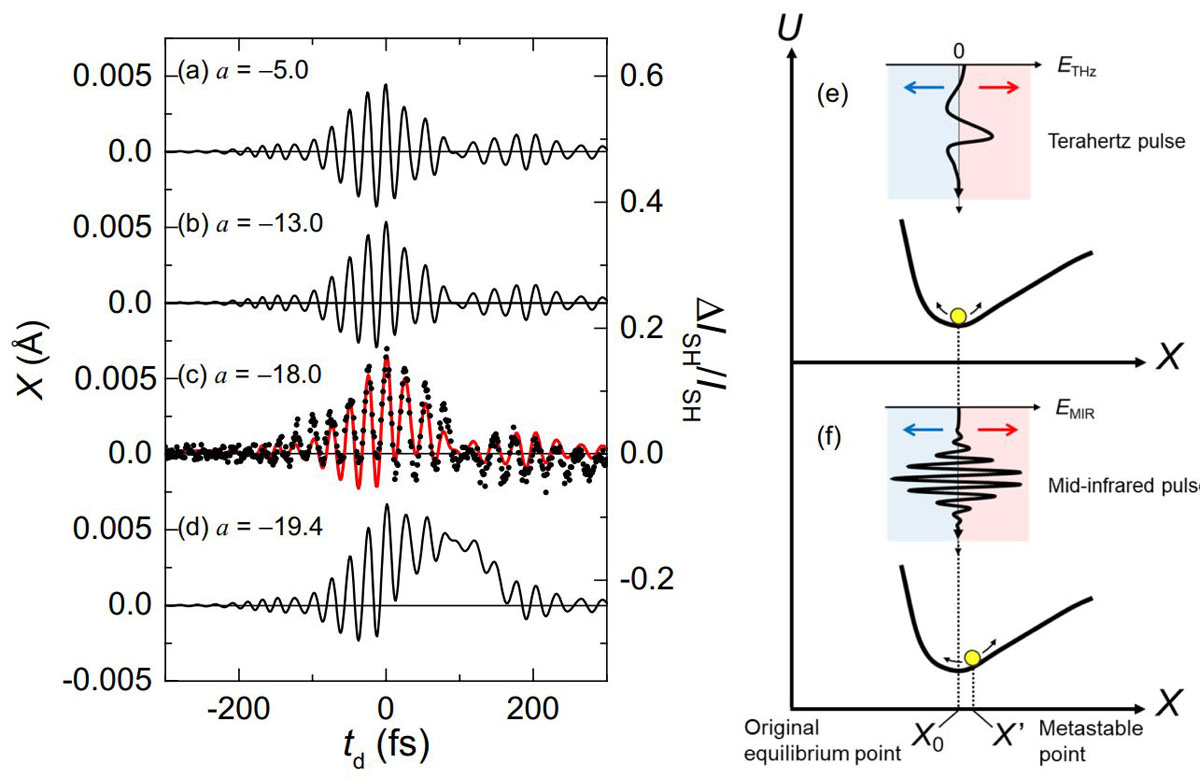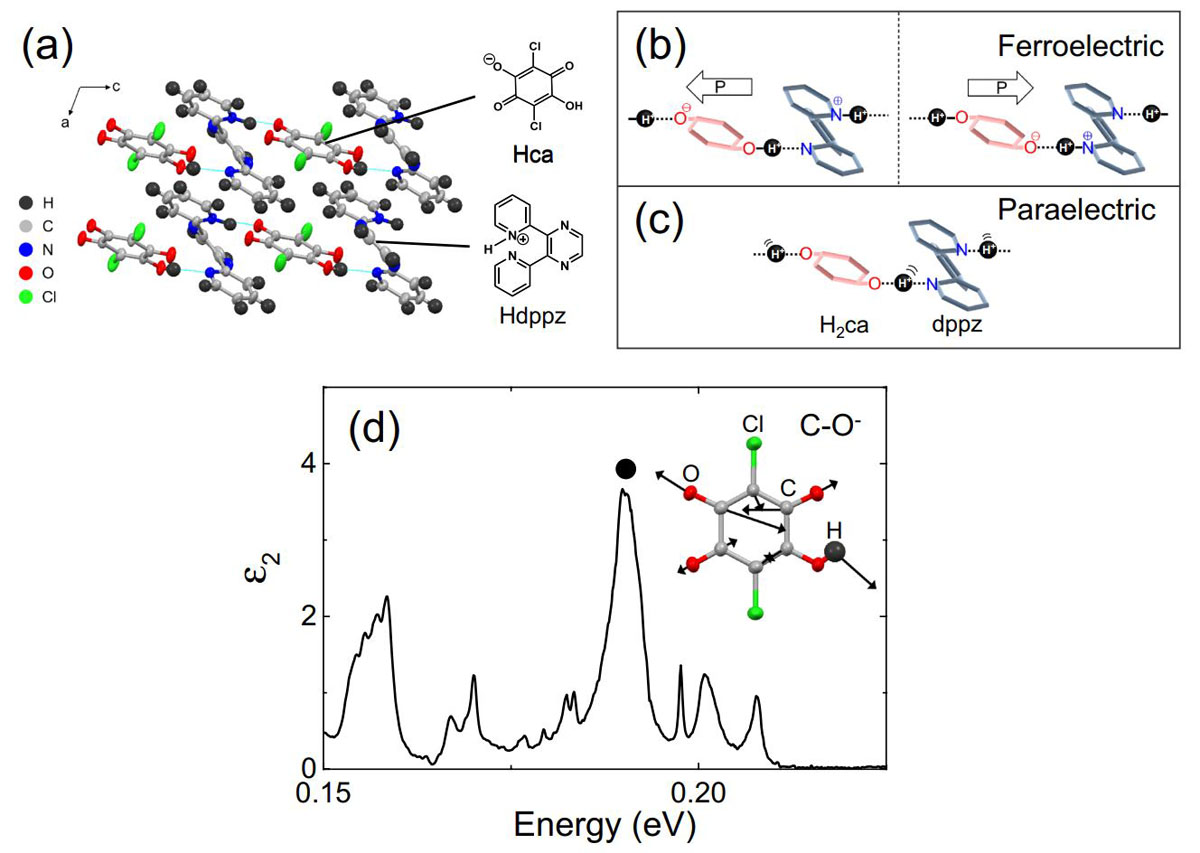Sub-Cycle Spectroscopy of Proton Transfer in Ferroelectric Cocrystals Driven by Intense THz and MIR Fields
T. Umanodan, Y. Okimoto, and J. Itatani
Ferroelectricity in organic materials is one of the most important topics in condensed matter physics. It has a wide range of practical applications because organic systems possess advantages such as mechanical flexibility, printability, disposability, and cost-effectiveness. Very recently, proton-mediated co-crystals have been developed as novel organic ferroelectric materials [1]. In these co-crystals, proton ordering along the hydrogen bonds between the proton-donor and -acceptor molecules leads to the emergence of ferroelectricity, leading to the lack of inversion symmetry. We focused on a proton-mediated co-crystal [H-dppz][Hca] (dppz = 2,3-di(2-pyridinyl)pyrazine, Hca = chloranilate) that shows ferroelectricity at room temperature (Tc = 402 K). Figure 1 shows the crystal structure (a), the ferroelectric and paraelectric origins due to the position of protons (b, c), and the imaginary part of dielectric constant at room temperature (d).
In this study [2], we investigated the ultrafast dielectric response of [H-dppz][Hca] by sub-cycle spectroscopy where carrier-envelope phase-stable intense optical pulses at 1 or 40 THz drove the ferroelectricity, then sub-cycle visible pulses probes the field-driven dynamics.
First, we irradiated the co-crystal with a single-cycle THz pulse at a center frequency around 1 THz with a maximum electric field of ~1 MV/cm, and measured the second harmonic (SH) of 100-fs laser pulses at 800 nm as a function of the relative delay between the THz and 800-nm pulses. The modulation of SH intensity exactly followed the waveform of the applied THz electric field, and the magnitude of the relative SH change reached up to 10%. This result indicates that the ultrafast change of the ferroelectricity was directly driven by the THz electric field.
Second, we irradiated the crystal with an intense mid-infrared (MIR) pulse (center frequency ~40 THz, maximum electric field ~30 MV/cm), and found that the induced SH change occurred very differently. The time profile of observed change of SH intensity was not scaled by the field profile of the 40 THz pulse as shown in Fig. 2(b). The SH change contained a component proportional to the square of the applied electric field in addition to the linear component that is proportional to the field as observed in the 1-THz case. These results suggest that the change of the polarity of the co-crystal cannot follow the oscillation of the electric field at 40 THz.

Fig. 2. (a-d) Calculated amplitudes of C-O- stretching mode for various anharmonic parameter a. The black circles in (c) denote the observed time profile of the SH intensity. (e, f) Schematic illustrations of the proton motion in the binding potential of the cocrystal when a THz or MIR pulse is applied. X0, X' denote the equilibrium position and a metastable position with excitation pulses, respectively.
To Understand these field effets, we analyzed the following nonlinear equation of motion that contains the C-O- stretching mode,
where χ(t) is the change in amplitude of the normal mode, which can be viewed as an index of the displacement of the atoms including the protons caused by the intense MIR electric field EMIR(t). We used the experimental data for EMIR(t) that was obtained by EO sampling with 6-fs visible pulses. The values μ, Ω, q, are the reduced mass, frequency, and effective charges of the C-O- mode derived from a DFT calculation and reflectivity data. We fit the observed time profile of ΔISH/ISH by numerically solving the above equation, and found that the observed signal ΔISH/ISH were well reproduced when a ≈ −18 Å-1fs-2, γ ≈ 0.75 eV, and k ≈ 26 Å−1 as shown by the solid line in Fig. 2. This result reveals the importance of phonon excitation in our observation of unconventional positive shift of ΔISH/ISH.
Figures 2(e, f) summarize the origins of the observed SH changes for THz and MIR excitation. In the presence of a strong MIR field that resonantly excites the C-O- stretching mode, dynamical repositioning of protons occurs, which leads to the asymmetric polarization. These results can be viewed as an example of ultrafast control of organic ferroelectric cocrystals using intense ultrafast laser pulses at room temperature.
References
- [1] S. Horiuchi, F. Ishii, R. Kumai, Y. Okimoto, H. Tachibana, N. Nagaosa, and Y. Tokura, Nat. Mater. 4, 163 (2005).
- [2] T. Umanodan, K. Kaneshima, K. Takeuchi, N. Ishii, J. Itatani, H. Hirori, Y. Sanari, K. Tanaka, Y. Kanemitsu, T. Ishikawa, S. Koshihara,S. Horiuchi, and Y. Okimoto, J. Phys. Soc. Jpn. 88, 013705 (2019).


